You’ll find photography more accessible with lightweight mirrorless cameras and compact fixed-lens options that reduce physical strain. Try simplified settings like auto-priority modes to decrease cognitive overwhelm, and add color-coded stickers for visual memory cues. Consider ergonomic straps, adaptive mounts, and built-in stabilization to accommodate mobility challenges. Don’t overlook smartphones with editing apps as a budget-friendly starting point. The right gear adaptations can transform photography into a truly therapeutic practice.
Lightweight Camera Options for Reduced Physical Strain
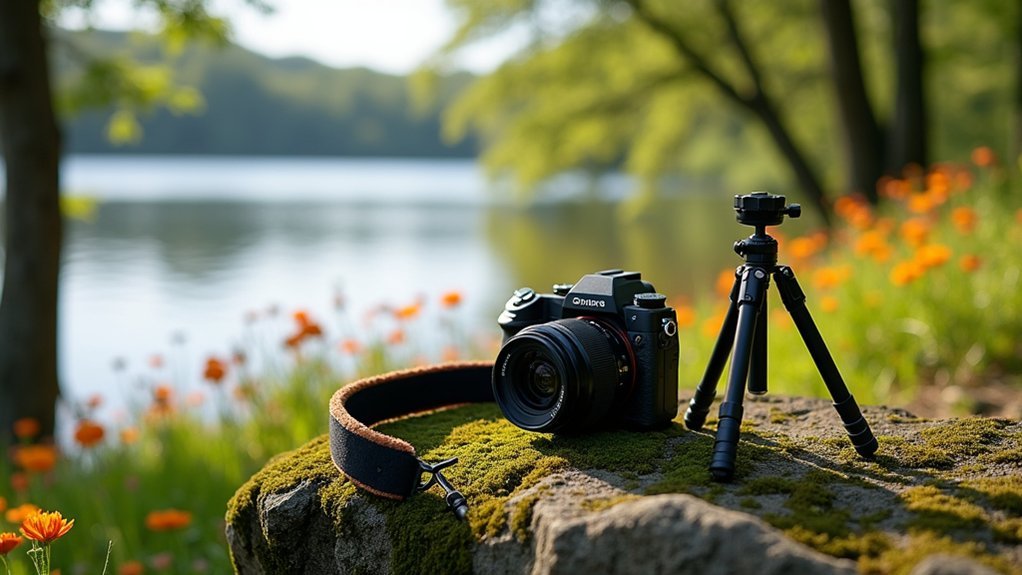
While many photographers focus primarily on image quality, the weight of your camera gear can greatly impact your physical comfort and mental wellbeing during shoots. Mirrorless cameras offer considerably lighter alternatives to traditional DSLRs, reducing strain during extended sessions.
Consider options like Fujifilm’s X-series or Sony’s Alpha lineup, which balance impressive image quality with manageable weight. For ultimate portability, compact fixed-lens cameras like the Ricoh GR III deliver professional results in pocket-sized packages. Taking regular walks with these lightweight cameras encourages physical movement while simultaneously nurturing your creative expression.
Lightweight systems like Fujifilm X and Sony Alpha deliver exceptional image quality without breaking your back or creative spirit.
Look for features that eliminate the need for extra equipment: built-in image stabilization reduces tripod dependency, while good high-ISO performance means you won’t need heavy lighting gear.
Models with ergonomic grips and intuitive controls also decrease both physical and mental fatigue, allowing you to focus on creative expression rather than technical complications.
Adaptive Tripods and Mounts for Limited Mobility
Photography equipment accessibility extends beyond just camera weight to how you position and stabilize your gear.
If you’re a wheelchair user, secure mounting options using standard tripod threads can attach cameras at ideal heights without constant handling.
Consider motorized pan and tilt heads with remote controls if you have limited dexterity from conditions like MS or cerebral palsy. These provide smooth vertical and horizontal movements with adjustable angle ranges and auto-pan features.
The DIY Wheelchair Mounted Tripod using the Manfrotto 190 Go tripod with a 500AH fluid video head offers excellent stability for wheelchair photographers.
Quick-deploy tripods like the Peak Design Travel Tripod offer fast setup with ergonomic quick-release systems ideal for limited hand mobility.
Meanwhile, flexible mounting systems with variable friction arms maintain position without requiring constant tightening.
For wheelchair-specific setups, options like the Super Clamp combined with adjustable mounts attach securely to frame tubes, enabling precise positioning with minimal physical strain.
One-Handed Camera Controls and Custom Grip Modifications
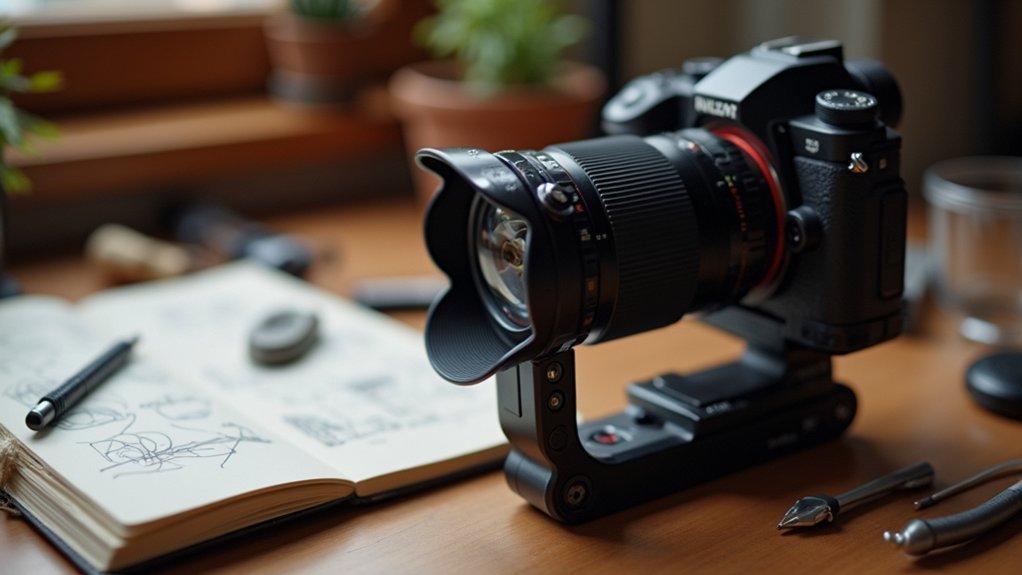
For photographers managing with only one hand, adapting your camera setup isn’t just convenient—it’s essential for maintaining creative expression despite physical limitations. Lighter mirrorless cameras paired with ergonomic grips make one-handed operation considerably easier.
Consider investing in a quality handstrap that secures the camera to your palm, freeing your fingers for controls. You’ll find stability improves when you position your thumb near the camera’s center and brace your elbow against your body. Experienced photographers recommend the Sony NEX6 for its lightweight design compared to heavier options like the Canon 6D.
A secure handstrap transforms your camera, creating stability through proper thumb placement and body positioning.
Take advantage of touchscreen autofocus and customize buttons to place essential functions within easy reach. For additional support, wrist straps with proper tension provide security without sacrificing quick access.
Don’t overlook DIY solutions—adding textured grip tape or custom-molded attachments can transform an awkward camera body into a personalized tool that works with your specific needs.
Voice-Activated Photography Tools for Hands-Free Operation
Voice-activated photography tools have revolutionized the way people with physical limitations capture images, offering freedom that traditional camera controls simply can’t match.
These innovative systems use advanced speech recognition to process commands like “take photo” or “start recording” without requiring physical interaction with your device.
You’ll find this technology increasingly available across platforms. iPhones offer Voice Control through accessibility settings, while Android users can utilize “Hey Google” commands. For dedicated cameras, manufacturers like Sony and Nikon are developing voice-command interfaces.
Beyond accessibility benefits, voice activation reduces stress during critical photography moments and lets you focus on composition rather than settings. The technology promotes natural interaction with your surroundings while still capturing meaningful memories.
Whether you’re shooting wildlife, family gatherings, or professional presentations, these hands-free solutions enhance both your creative process and mental wellbeing.
Simplified Camera Settings for Cognitive Processing Challenges
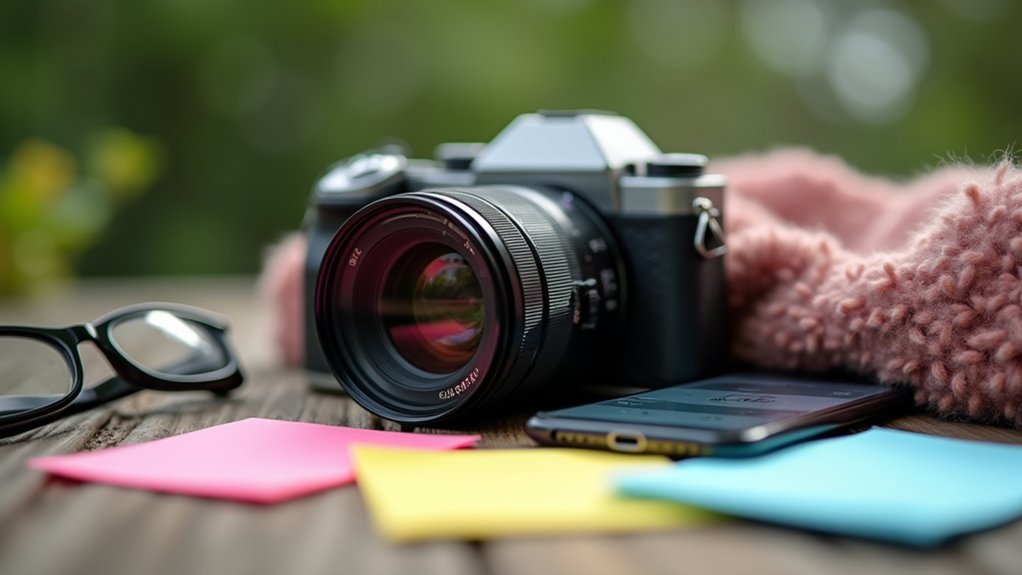
You’ll find relief from cognitive overwhelm by reducing your camera’s settings to just the essentials you need for each shooting session.
When facing processing challenges, utilize auto-priority modes that handle exposure calculations while still giving you creative control over composition and timing.
Consider adding color-coded stickers or tape to mark your frequently used settings, creating visual cues that bypass the need for complex mental recall.
Research shows that simplified interfaces can decrease cognitive load, which is beneficial since increased mental demand is directly associated with higher error rates in task performance.
Simplified Camera Settings for Cognitive Processing Challenges
When cognitive processing challenges make photography seem overwhelming, simplifying your camera settings can transform the experience from stressful to therapeutic. Start by using your camera’s center focus point, which reduces variables you need to process while shooting.
Consider a point-and-shoot camera with fewer settings or find a comfortable balance between manual and automatic controls on more advanced models. Research shows that reducing this complexity aligns with cognitive load theory, potentially lowering anxiety and increasing your confidence behind the lens. Setting your camera to AV mode allows you to control just one variable – aperture – while the camera handles shutter speed automatically.
Try sticking with one focal length rather than constantly changing it, and implement simple heuristic rules like always re-centering your subject.
These adjustments minimize cognitive strain, making photography more accessible and allowing you to focus on the therapeutic benefits rather than technical complexities.
Auto-Priority Modes Matter
Auto-priority modes represent a cornerstone of simplified photography for those facing cognitive challenges. When you’re feeling overwhelmed, these modes reduce decision fatigue while maintaining creative control.
Auto mode handles all settings, allowing you to focus entirely on capturing the moment rather than technical details. It’s not “less professional”—it’s a stress-reduction tool.
Aperture priority gives you depth-of-field control while the camera manages shutter speed—perfect for landscapes or portraits where you need specific focus areas. This mode is particularly beneficial as it is preferred by professionals for 95% of landscape photography scenarios.
Shutter priority lets you capture motion exactly as you want—freezing action or creating artistic blur—while the camera handles the rest.
These semi-automatic modes aren’t just convenient; they’re accessibility tools that make photography more inclusive by reducing cognitive load and anxiety.
Color-Coded Setting Reminders
Three powerful yet often overlooked tools in mental health photography are color-coded reminders for camera settings. When cognitive processing feels overwhelming, these visual cues can dramatically reduce stress and enhance your creative experience. Color selection for your system creates a significant opportunity to influence your emotional response, similar to how filmmakers use color grading to guide audience feelings.
| Color | Camera Setting | Emotional Association |
|---|---|---|
| Red | Aperture wide | Energy, excitement |
| Blue | Landscape mode | Calm, serenity |
| Green | Macro setting | Growth, nature |
| Yellow | Fast shutter | Alertness, brightness |
This system creates consistent visual shortcuts that bypass cognitive overload. You’ll develop associative memories that trigger automatically in stressful situations. Consider customizing your color scheme to match personal preferences—what matters is establishing a consistent pattern that works for your brain. When implemented thoughtfully, color-coding transforms complicated technical decisions into intuitive choices, freeing your mind to focus on the mindfulness benefits of photography.
Anxiety-Reducing Camera Straps and Carrying Solutions
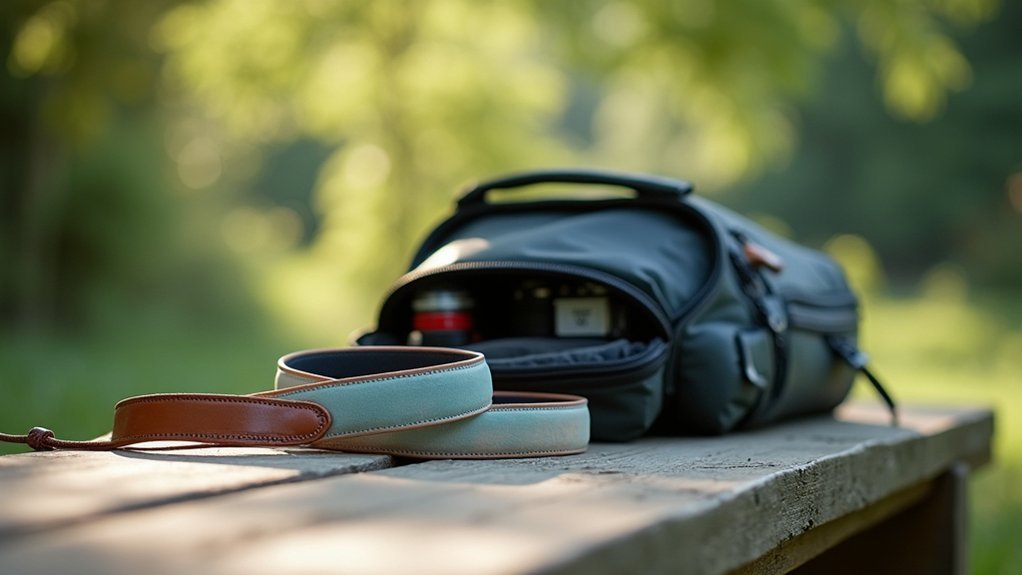
For photographers struggling with anxiety, the right camera strap or carrying solution can make a significant difference in your overall experience. Ergonomically designed straps distribute weight effectively, reducing fatigue during long shoots while providing the security of knowing your equipment won’t fall.
Consider your specific needs: wrist straps offer customizable comfort for quick shooting, while dual straps and harness systems distribute weight across both shoulders when carrying heavier gear. Many expedition photographers prefer systems like the Black Rapid that allow cameras to slide up and down the strap for quick access. Sling straps provide flexibility and easy access without sacrificing security.
The psychological benefits extend beyond physical comfort—with your camera securely attached, you’ll gain confidence and freedom to focus on creativity rather than equipment safety.
Weather-resistant materials and adjustable features further reduce stress during challenging shoots, allowing your mind to stay present with your subject instead of worrying about your gear.
Budget-Friendly Adaptive Photography Equipment
Pursuing photography as a therapeutic practice shouldn’t require expensive equipment, especially for those with specific accessibility needs.
Consider Therapro’s digital cameras designed specifically for individuals with physical disabilities or learning challenges, offering accessible memory storage options.
You’ll find great value in purchasing pre-owned gear or exploring Sony’s accessibility-focused camera kits.
Open-source camera modifications also provide customizable solutions without breaking the bank.
Don’t underestimate what you already have—smartphones paired with apps like VSCO or Snapseed deliver powerful editing capabilities.
Add affordable mobile stabilizers or gimbals to improve image quality if you struggle with steadiness.
Therapro’s Adapted Digital Camera connects to external switches for easy operation, making photography accessible for users with various mobility limitations.
For specialized needs, explore AI-powered photography tools that automatically adjust settings, or camera remote control apps that benefit those with mobility limitations.
Sensory-Friendly Viewfinders and LCD Screens
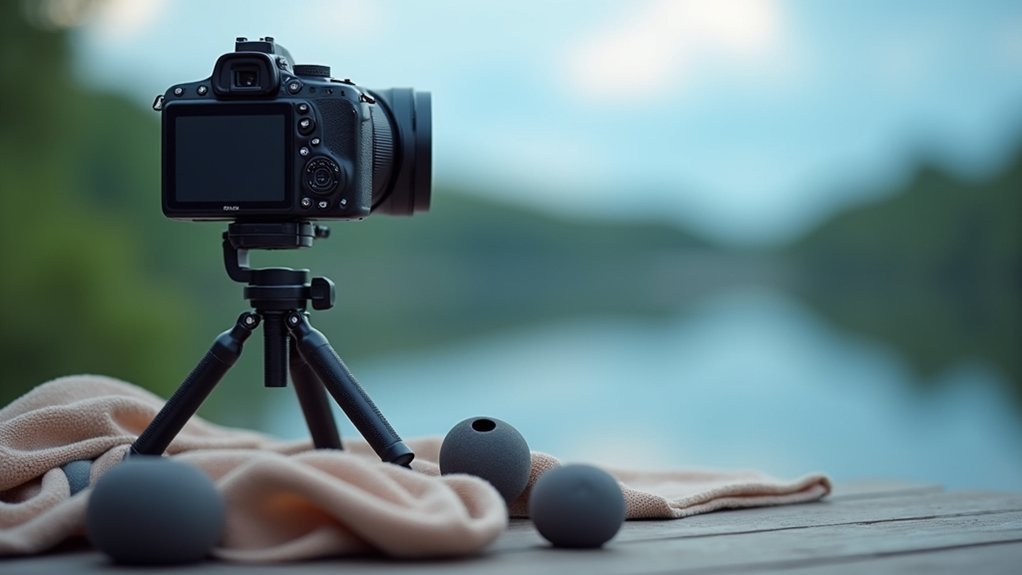
Individuals with sensory sensitivities often struggle with traditional camera displays, making specially designed viewfinders and LCD screens essential therapeutic tools. When choosing camera equipment, consider these sensory-friendly features to create a more comfortable photography experience. Remote Live View capabilities can provide additional distance from potentially overwhelming camera equipment while maintaining full control of photography functions.
| Viewfinder Type | Benefits for Sensory Needs |
|---|---|
| Optical | Blocks external light, reduces stimuli |
| Electronic | Customizable brightness, focus peaking |
| Smartphone Attachments | Portable, reduces screen glare |
| Adjustable Diopters | Accommodates visual processing differences |
| Light-Blocking Eyecups | Minimizes peripheral distractions |
Look for cameras with adjustable diopters to match your visual needs, or add light-blocking accessories to existing equipment. For autism or sensory processing challenges, viewfinders offer a focused visual interface that can reduce overload while improving concentration and enjoyment of photography.
Tremor-Reducing Stabilization Technologies
When trembling hands threaten to blur your photographic vision, specialized stabilization technologies can transform frustration into artistic freedom.
Optical stabilization moves lens elements to counteract camera shake, primarily correcting pitch and yaw rotations detected by gyroscopic sensors.
Precision gyroscopes detect the slightest tremors, engaging microscopic lens adjustments that transform shaky movements into smooth, professional imagery.
For a more thorough solution, consider cameras with sensor-shift stabilization, which moves the actual sensor to offset tremors and works with any lens, including vintage options without built-in stabilization. This approach provides up to four stops advantage when shooting at slower shutter speeds than normally possible.
If you’re managing essential tremor, explore wearable assistive devices like the Cala kIQ™ System, which uses patterned nerve stimulation to reduce hand tremors.
Pair these with mechanical supports – quality tripods provide complete isolation from body movements, while gimbals offer dynamic stabilization for moving shots.
Memory-Assisting Photography Apps and Accessories
For those struggling with memory challenges, photography has evolved beyond mere image capture into a powerful cognitive support tool. Apps like HippoCamera can boost memory recall by over 50% through video and audio combinations that mimic your brain’s natural memory processes.
Kodak’s “Memory Shots” helps dementia patients reconstruct visual memories through AI-generated imagery that serves as cognitive cues. The tool encourages deeper conversations between patients and caregivers when discussing the generated images.
- Use photo diary apps to chronologically document daily experiences with notes or audio tags, reinforcing neural pathways similar to your hippocampus.
- Complement memory apps with mindfulness tools like Insight Timer to reduce stress, which directly improves cognitive function and memory performance.
- Look for apps with accessible interfaces designed for minimal cognitive load and customizable prompts tailored to your specific memory needs.
Therapeutic Photography Kits for Inpatient Settings
Therapeutic photography kits for inpatient settings should include lightweight, portable equipment that won’t overwhelm patients during emotional healing.
You’ll want to guarantee all camera controls are accessible with simplified interfaces and clear labeling to accommodate varying skill levels and cognitive abilities.
Consider trauma-informed design elements like soft cases, non-triggering sounds, and adaptable accessories that create psychological safety for patients working through difficult emotions.
The kits should focus on equipment that supports patients in visually expressing fluid identity as they navigate significant personal changes during treatment.
Lightweight Portable Solutions
Creating effective therapeutic photography kits for inpatient settings requires thoughtful consideration of portability without sacrificing functionality.
You’ll want equipment that’s both easy to transport between rooms and simple enough for patients with varying ability levels to use.
- Mirrorless cameras offer the perfect balance of image quality and weight reduction – they’re considerably lighter than DSLRs while maintaining professional-grade results and interchangeable lens options.
- Compact lighting solutions like foldable LED panels or clip-on ring lights can dramatically improve photo quality without adding bulk to your kit.
- Backpack or sling carriers designed specifically for camera gear provide padded protection while distributing weight comfortably, allowing you to transport tripods, multiple lenses, and accessories between therapy sessions without strain.
Using high ISO settings between 5,000-10,000 can help you capture clear images in the typically dim lighting conditions of hospital rooms without disturbing patients.
Accessible Camera Controls
When designing therapeutic photography kits for inpatient settings, accessible camera controls serve as the critical interface between patients and their creative expression.
Look for cameras with intuitive interfaces featuring large, simple buttons that accommodate users with dexterity issues or cognitive impairments.
Your ideal setup should include adjustable settings for brightness and contrast to match individual preferences.
Consider both manual and autofocus options depending on patient skill levels. For those with motor challenges, lightweight cameras with ergonomic grips and mounting options like tripods can greatly improve usability.
Don’t overlook the importance of large, clear LCD displays for users with visual impairments.
Remember that durability matters too—choose cameras robust enough to withstand frequent handling and cleaning in healthcare environments. Studies have shown photography-based activities can facilitate personal growth and well-being among participants while promoting therapeutic outcomes.
Trauma-Informed Equipment Design
Developing trauma-informed photography kits requires thoughtful consideration of both physical equipment and the emotional environment they create. When designing these kits for inpatient settings, prioritize safety, comfort, and empowerment to support healing journeys.
- Create a safe space by using ergonomic equipment with minimal distracting sounds, incorporating natural lighting, and offering privacy screens that reduce exposure anxiety while allowing creative expression. The environmental setup should minimize any potential for re-traumatization during the photography experience.
- Personalize the experience through flexible setups that accommodate individual preferences, soothing color palettes, and familiar items that create a sense of ownership and comfort.
- Empower through choice by offering intuitive interfaces that don’t overwhelm, providing various aesthetic options, and ensuring equipment is durable enough to withstand regular use without causing frustration.
Frequently Asked Questions
Can Photography Improve Clinical Depression Without Medication?
Photography can improve clinical depression without medication by activating positive psychology mechanisms. You’ll benefit from its therapeutic effects, including emotional expression, mindfulness practice, and cognitive reframing while capturing meaningful moments.
How Does Low-Light Photography Impact Anxiety Levels?
Low-light photography can impact your anxiety in multiple ways. You’ll find it promotes mindfulness and creative expression, but might face increased stress from technical challenges. The calm, focused activity often balances circadian disruption effects.
Does Photo Journaling Help With Trauma Processing?
Yes, photo journaling helps you process trauma effectively. You’ll benefit from externalizing painful memories, gaining psychological distance, and bypassing verbal limitations. It’s especially powerful when you combine images with written reflections about your experiences.
What Photographic Techniques Best Support Dissociative Disorders?
Mindfulness photography helps you stay present, reducing dissociative symptoms. You’ll benefit from techniques that give you control and agency while allowing creative expression. Try photo journaling to process emotions and collaborate between dissociative parts.
Can Photography Alleviate Symptoms of Seasonal Affective Disorder?
Yes, photography can alleviate SAD symptoms. You’ll benefit from the outdoor exposure to natural light, creative engagement, and mindfulness. It’s not a replacement for medical treatment but works well as complementary therapy.
In Summary
You don’t need expensive specialized equipment to make photography accessible for your mental health journey. With these simple hacks and adaptations, you’ll find ways to express yourself despite physical limitations, cognitive challenges, or sensory sensitivities. Whether you’re managing tremors, reducing strain, or seeking hands-free options, there’s a solution that fits your needs. Photography remains a powerful therapeutic tool that’s within your reach, regardless of your circumstances.

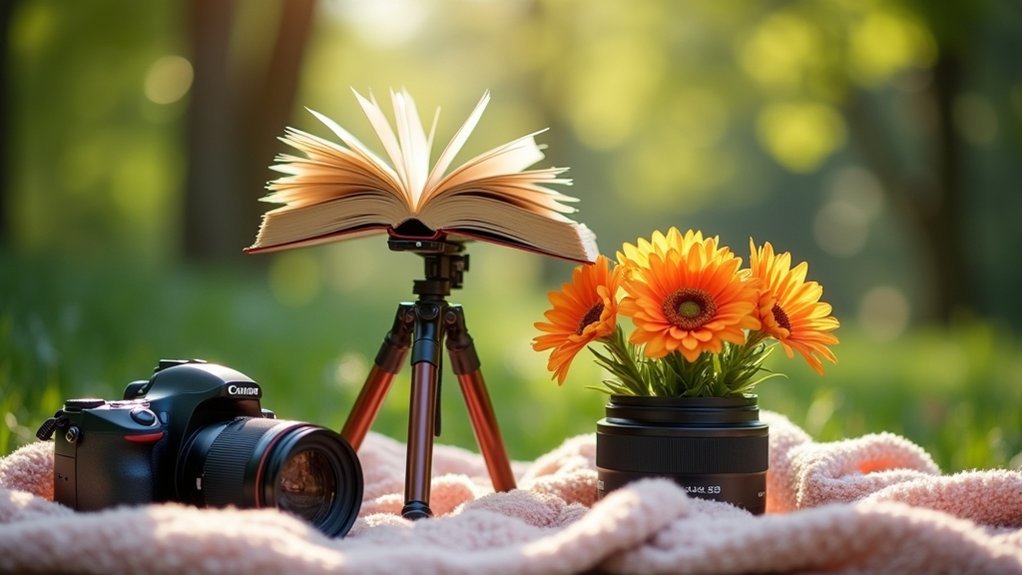



Leave a Reply